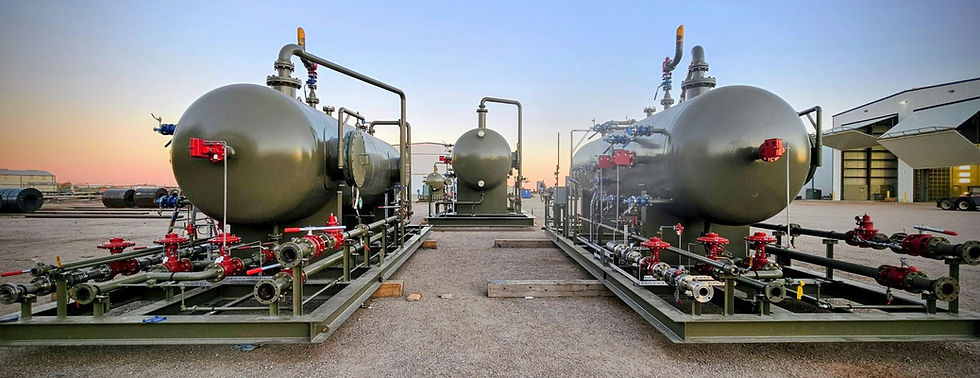The Strategic Edge of In-House Engineering for Oil and Utility
- mwolverton3
- Jun 18
- 3 min read

When oil and utility companies keep critical technical work under their own roof, they gain more than bragging rights. An in-house engineering and design culture creates faster feedback loops, tighter cost control, and a deeper institutional knowledge base that ripples across safety, compliance, and long-term competitiveness.
What “In-House Engineering and Design” Really Means
At Smith Industries, “In House” covers the full life cycle, conceptual layouts, 3-D modeling, stress analysis, procurement support, and as-built documentation, performed by staff who sit steps away from fabrication bays and field service planners. This proximity removes the silos that often slow external consultant engagements and allows real-time corrections when ground conditions shift or client priorities evolve.
Speed and Agility in Project Execution
Transportation agencies have documented that involving utility engineers early slashes relocation delays, avoids costly redesigns, and smooths right-of-way negotiations. The same principle applies to pipeline terminals, substations, and compressor stations. When designers can walk to the shop floor, clarify a weld prep, or pull historical drawings from the internal vault, decisions that once took days happen in minutes. The result is shorter critical paths and faster revenue generation for owners.
Cost Control and Predictable Budgets
Pacific Northwest National Laboratory notes that in-house development of complex energy information systems can carry a distinct cost advantage, provided staff have the skills to build and maintain the platform. Translate that to mechanical and electrical design, and the math still works: eliminating third-party mark-ups, travel charges, and multiple layers of project management keeps budgets lean. Direct control over specifications also curbs expensive change orders that stem from miscommunication between separate firms.
Knowledge Retention Fuels Innovation
Contract designers depart when the contract ends; internal engineers stay to dissect field failures, update standards, and mentor rising talent. Over the decades, Smith Industries has built libraries of proprietary finite element models, stress-corrosion data, and material test results that inform every new vessel or skid. This institutional memory sparks incremental design tweaks, slightly thicker web stiffeners, and refined weld sequences that compound into measurable reliability gains.
Integrated Safety and Compliance
API 650 tank rules and OSHA excavation clearances intersect at nearly every oil or utility site. When safety professionals and designers sit in the same daily stand-up, code requirements are baked into drawings from day one instead of bolted on later. Internal teams also react faster to regulatory updates, quickly revising standard details or procurement specs without waiting for an external revision cycle.
Economic Impact Extends Beyond the Plant Gate
The American Council of Engineering Companies reports that every dollar generated by engineering and design firms contributes an additional $1.50 to U.S. GDP, reflecting high spillover effects into manufacturing, technology, and construction supply chains acec.org. By keeping those high-value tasks inside company walls, and often inside the communities where Smith Industries operates, local economies gain skilled jobs, higher wages, and a stronger tax base.
Case in Point: Smith Industries’ Utility Project Example
Smith Industries’ utility division recently delivered a project on time. Because structural, electrical, and controls engineers were onsite:
Fewer change orders. Field crews requested a conduit routing change; designers updated drawings the same afternoon, avoiding a two-day hold.
Lifecycle insight. The maintenance group reviewed panel layouts upstream, reducing long-term service costs.
Building a Pipeline of Talent
In-house engineering and design thrive on continuous learning. Smith Industries funds PE licensure, weld-coupon research, and digital-twin training because every dollar spent on professional growth multiplies in project performance. Retention rates rise, tribal knowledge deepens, and recruitment becomes easier when graduates see a clear technical career path.
Looking Ahead: Digital Integration
Cloud-based design environments and real-time sensor feedback blur the line between engineering, fabrication, and operations. Companies that already house multidisciplinary teams are best positioned to adopt digital twins, predictive maintenance, and AI-driven optimization without outsourcing their core intellectual property.
Conclusion
Whether the goal is faster delivery, smoother inter-tie approvals, or safer grid upgrades, In-house engineering and design delivers tangible strategic advantages. Smith Industries’ experience and the broader industry data show that keeping critical technical capabilities close to production not only accelerates projects but also builds durable economic value for clients, communities, and the nation’s energy future.




Comments